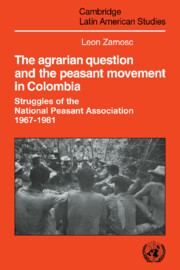 The Agrarian Question and the Peasant Movement in Colombia
The Agrarian Question and the Peasant Movement in Colombia Book contents
- Frontmatter
- Contents
- List of tables, figures, and maps
- Foreword by Tedor Shanin
- Foreword by UNRISD
- Acknowledgments
- List of abbreviations
- Map 1 Republic of Colombia
- Introduction
- 1 The agrarian question in Colombia
- 2 Reformism and the beginnings of the peasant movement
- 3 The radicalization of ANUC and the great waves of land invasions
- 4 Counterreform
- 5 The contradictory influences of peasant politicization
- 6 Concessions and repressive escalation
- 7 The new occupational alternatives and the issue of the rural proletariat
- 8 Partial repeasantization and the question of the new peasant settlements
- 9 Final crisis and clientelist regression of ANUC
- 10 Overview and final remarks
- Notes
- Bibliography
- Index
- Cambridge Latin American Studies
9 - Final crisis and clientelist regression of ANUC
Published online by Cambridge University Press: 10 October 2009
- Frontmatter
- Contents
- List of tables, figures, and maps
- Foreword by Tedor Shanin
- Foreword by UNRISD
- Acknowledgments
- List of abbreviations
- Map 1 Republic of Colombia
- Introduction
- 1 The agrarian question in Colombia
- 2 Reformism and the beginnings of the peasant movement
- 3 The radicalization of ANUC and the great waves of land invasions
- 4 Counterreform
- 5 The contradictory influences of peasant politicization
- 6 Concessions and repressive escalation
- 7 The new occupational alternatives and the issue of the rural proletariat
- 8 Partial repeasantization and the question of the new peasant settlements
- 9 Final crisis and clientelist regression of ANUC
- 10 Overview and final remarks
- Notes
- Bibliography
- Index
- Cambridge Latin American Studies
Summary
Generalized decline and last land struggles
The deterioration of the influence of ANUC Sincelejo was not confined to the areas of land struggle. After the Third National Congress there had been a steep decline on the other fronts of the peasant movement, where economic and special demands had prevailed from the beginning. As will be seen in the following section, this decline was related to the government policy of partial concessions, which exerted as much influence as the problems and obstacles that hindered radical ANUC from taking up the demands of the landed peasants. However, an aggravating factor in ANUC's crisis was the bureaucratic style of vertical leadership that had taken hold of the organization. Although it is true that radicalism had been less marked in the areas of peasant economy and colonization, the better-organized sectors in these areas had originally exerted great influence at the grass-roots level and had distinguished themselves by massive belligerent action during the early stage of ANUC's confrontation: the civil strikes that shattered the colonization areas of Caquetá and Sarare; the strikes and mobilizations that galvanized the minifundistas of Quinchía, Nariño, and other points on the highlands; and the land struggles and reconstruction of resguardos conducted by CRIC among the Indian communities of Cauca. From the organizational point of view, in all these cases the rise of the movement had been marked by autonomous regional consolidation, which encouraged and sustained the criticism of ANUC's central leadership.
These criticisms were basically of three types.
- Type
- Chapter
- Information
- The Agrarian Question and the Peasant Movement in ColombiaStruggles of the National Peasant Association, 1967–1981, pp. 179 - 201Publisher: Cambridge University PressPrint publication year: 1986


